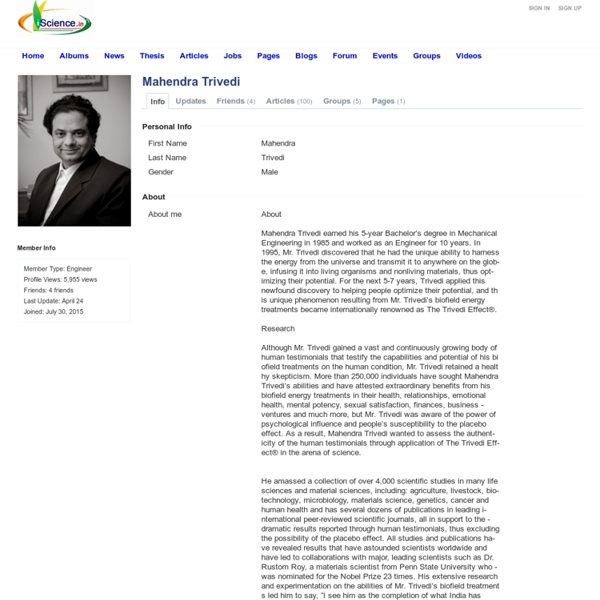Mahendra Kumar Trivedi | OMICS International | Madhya P
Mahendra Kumar Trivedi completed his Bachelor’s degree in Mechanical Engineering in 1985 and worked as an Engineer for 10 years. In 1995, Mr. Trivedi discovered that he has the unique ability to harness the energy from the universe and transmit it to anywhere on earth, infusing it into living organisms and nonliving materials to optimize their potential. With this ability, Mr. Trivedi is a natural healer. He began healing people and optimizing their potential, and this extraordinary phenomenon became internationally renown as The Trivedi Effect®.
figshare
Biofield Independent Researcher Henderson, NV, US Mahendra Kumar Trivedi earned his 5-year Bachelor’s degree in Mechanical Engineering in 1985 . Mahendra Kumar Trivedi worked as an Engineer for 10 years. In 1995, Mr. Trivedi discovered that he had the unique ability to harness the energy from the universe and transmit it to anywhere on the globe, infusing it into living organisms and nonliving materials, thus optimizing their potential. Publications
Biofield Impact on Biotype Number of R. Ornithinolytica
Description Raoultella ornithinolytica is belongs to the family of Enterobacteriaceae, a Gram-negative encapsulated aerobic bacillus associated with bacteremia and urinary tract infections. As biofield therapy is increasingly popular in biomedical heath care, so present study aimed to evaluate the impact of Mr. Trivedi’s biofield treatment on antimicrobial sensitivity, minimum inhibitory concentration (MIC), biochemical study, and biotype number of multidrug resistant strain of R. ornithinolytica. Clinical sample of R. ornithinolytica was divided into two groups i.e. control and biofield treated which were analyzed for the above parameters using MicroScan Walk-Away® system on day 10 after treatment. Antimicrobial sensitivity assay results showed a significant increase (60.71%) in sensitivity pattern of antimicrobials i.e. changed from resistant to susceptible while 10.71% of tested antimicrobials changed from intermediate to susceptible as compared to control. Citation Information
Trivedi Effect (0000-0003-2746-0843) - ORCID | Connecting Research and Researchers
The Trivedi Effect is a natural phenomenon that exists within our universe. Trivedi Effect is a world-renowned, natural phenomenon of transforming living organisms & non-living materials to perform at the highest level. Mahendra Kumar Trivedi has this incredible ability to transform living organisms & non-living substances. Trivedi Effect® is a Unique phenomenon, created by Mahendra Trivedi. According to over 4,000 scientific studies conducted at research institutes throughout the world, has the ability to transform both living & non-living matter on a fundamental level.
Trivedi Effect for iOS
Pros In this app the latest information and online video can be seen. Cons Like the app as Trivedi Effect is something amazing for which i got curious to know and downloaded from Google Playstore Reply to this review Was this review helpful? Through this Trivedi Effect App, i was able to connect through Mahendra Trivedi and join his upgraded program. Since upgrading to the Daily Transmission Program, there is such a difference in growth in consciousness. The online webcast related to Trivedi Effect can be watched. The description on Google play store is about the Trivedi Effect. Good one, Easily get the latest information about The Trivedi Effect and all the online webcast can be watched. what benefits the user can take through this app should be described. Summary This Application is good but need to improve the design and some additional offers should be given. Was this review helpful? Need to roll out improvements in look. This app is really amazing. Easily downloaded through Google play store
Citrobacter Braakii – Study of Biochemical Characteristics
Abstract Citrobacter braakii (C. braakii) is widespread in nature, mainly found in human urinary tract. The current study was attempted to investigate the effect of Mr. Keywords: Citrobacter braakii; Antimicrobial susceptibility; Biofield treatment; Biochemical reaction; Biotype; 16S rDNA analysis; Gramnegative bacteria; Enterobacteriaceae Abbreviations: MDR: Multi-Drug Resistant;ATCC: American Type Culture Collection; NBPC 30: Negative Breakpoint Combo 30; MIC: Minimum Inhibitory Concentration; OTUs: Operational Taxonomic Units; NCBI: National Center for Biotechnology Information; MEGA: Molecular Evolutionary Genetics Analysis; PCR: Polymerase Chain Reaction; RDP: Ribosomal Database Project; HBMEC: Human Brain Microvascular Endothelial Cells . Introduction Citrobacter braakii (C. braakii) is a genus of Gram-negative, straight, facultative anaerobic and motile bacilli bacterium widely distributed in water, soil, and food in the environment. Materials and Methods Experimental design 1.
NCBI Sign In Page
Trivedi Effect
Thermal, Spectroscopic and Chemical Characterization of Biofield Energy Treated Anisole Trivedi Effect Mahendra Kumar Trivedi Alice Branton Dahryn Trivedi Published in Organic Chemistry Current Research in October 2015 The objective of the present study was to evaluate the impact of biofield energy treatment on the thermal, spectroscopic, and chemical properties of anisole by various analytical methods such as gas chromatography-mass spectrometry (GC-MS), high performance liquid chromatography (HPLC), differential scanning calorimetry (DSC), Fourier transform inf... Characterization of Biofield Energy Treated 3-Chloronitrobenzene: Physical, Thermal, and Spectroscopic Studies Trivedi Effect Alice Branton Mahendra Kumar Trivedi Dahryn Trivedi Published in International Journal of Waste Resources in October 2015 The chloronitrobenzenes are widely used as the intermediates in the production of pharmaceuticals, pesticides and rubber processing chemicals.



